Soyuz launches a Meteor weather satellite and hitchhikers (original) (raw)
Soyuz launches a Meteor weather satellite and hitchhikers
A Soyuz-2-1b rocket lifted off from the Vostochny spaceport on June 27, 2023, carrying the Meteor-M2-3 weather and climate-monitoring spacecraft, along with a cluster of small satellites, including a trio of experimental satellites for the Buro 1440 satellite Internet project (INSIDER CONTENT).
Previous chapter: Meteor-M2-2 launch
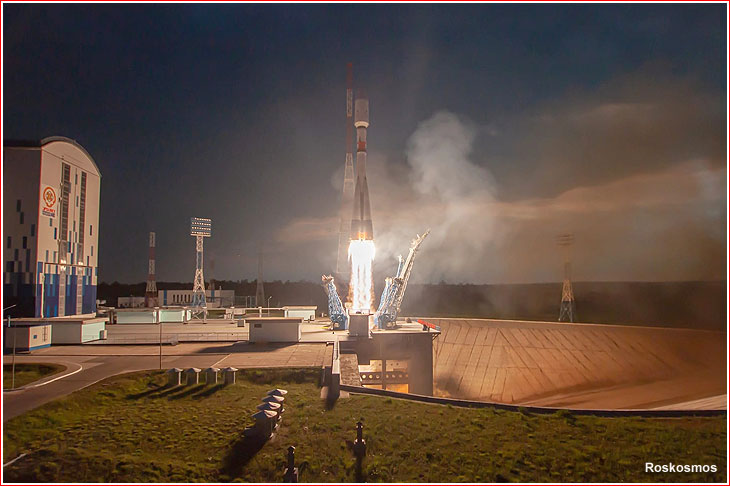
The Meteor-M2-3 mission at a glance:
| Payload | Meteor-M No. 2-3 and 42 secondary payloads |
|---|---|
| Launch vehicle | Soyuz-2-1b / Fregat |
| Launch site | Vostochny, Soyuz complex 1S |
| Launch date and time | 2023 June 27, 14:34:49.415 Moscow Time (actual) |
| Payload section, KGCh (RB, PO, KA, GO) | 7,932 kilograms |
| Mission status | Success |
Meteor-M2-3 satellite
The Meteor-M No. 2-3 satellite (a.k.a. Meteor-M2-3) is the fifth spacecraft in the Meteor-M series introduced in 2009, counting one lost in a launch mishap in 2017.
As the rest of the Meteor family, the spacecraft was built at Moscow-based VNIIEM Corporation, which relied on its standard Resurs-UKP-M platform as a service module for the mission. According to its documentation, a spacecraft of this type is certified to operate in orbit for no less than five years.
Like its predecessors, the nearly three-ton satellite is designed to watch global weather, the ozone layer, the ocean surface temperature and ice conditions to facilitate shipping in the polar regions of our planet. Its military use is also purported.
Despite its designation as a standard vehicle in the series, the Meteor-M2-3 differs from its predecessors by the presence of a deployable phased-array radar antenna for all-weather scanning of the Earth. It was also equipped for the first time with a short-way monitor of reflected radiation and a radio-frequency mass spectrometer for heliophysics studies of the solar radiation.
At least one more Meteor-M2 variant was planned for launch within a year from the successful deployment of the M2-3 spacecraft. As of June 2023, the launch of Meteor-M2-4 was promised before the end of the year. At the same time, Meteor M2-5 and Meteor M2-6 were in production at VNIIEM.
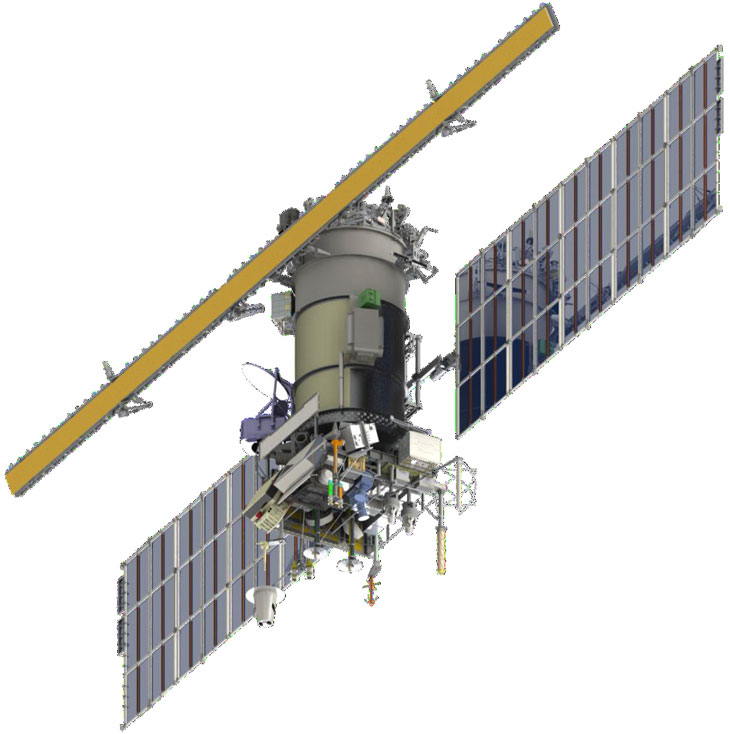
Known specifications of the Meteor-M No. 2-3 satellite:
| Orbit | Sun-synchronous |
|---|---|
| Orbital inclination | 98.57 degrees toward the Equator |
| Orbital altitude | 832 kilometers |
| Spacecraft liftoff mass | 3,250 kilograms |
| Spacecraft payload mass | approximately 1,250 kilograms |
| Cost | 4,098,400 rubles (as of 2020) |
Secondary payloads
Typically for Soyuz missions to near-polar orbits, the rocket had a considerable extra payload capacity to its primary passenger. Previously, Roskosmos' commercial arm Glavkosmos offered that available mass to commercial users outside Russia. However, the growing political and economic isolation of Moscow in the 2020s (INSIDER CONTENT) drove traditional Western partners away from Roskosmos and toward its competitors, such as the US, India and China. Instead, the Russian industry turned to the internal market and to a few remaining countries who continued doing business with Russia. All of them combined could provide only a fraction of the mass (and therefore revenue) previously brought by the Westerns, but for the Meteor-M2-3 mission, these clients booked a record-breaking number of payloads. Ironically, most of the hitchhiker payloads relied on Western-developed architectures, first of all the CubeSat standard.
One of the main customers providing secondary payloads for the Meteor-M2-3 mission was the Moscow-based Innovations Support Fund which sponsored the launch of 16 university satellites in the CubeSat format under the Space-π (Space-Pi) project. Roskosmos itself funded nine educational satellites under its UniverSat program. A total of 17 other payloads were identified as commercial.
Also, after the exit of a German-based payload integrator, a Russian company called Aerospace Capital took over processing operations in support of commercial customers. For the Meteor-M2-3 mission, the company installed nine deployment containers on the Fregat upper stage for subsequent deployment in orbit of 16 Space-Pi CubeSats, a 12U PHI-Demo CubeSat, developed at the Mohammed Bin Rashid Space Center in the United Arab Emirates, a Malaysian 6U CubeSat and 11 CubeSats for Russian customers.
Some larger payloads could probably be deployed without use of launch containers.
Secondary payloads aboard the Soyuz launch on June 27, 2023:
| No | Spacecraft | Mission/Type | Developer / Operator |
|---|---|---|---|
| 1 | Meteor-M No. 2-3 | Remote-sensing (primary payload) | VNIIEM |
| 2 | Akhmat-1 | Space-π project: Aircraft identification | South-Western State University, Chechen State University |
| 3 | ArcCube-01 (3U CubeSat) | Space-π project: communications, amateur radio | Firon center, Rostov Region |
| 4 | A-SEANSat-PG1 (6U cubesat), | Remote-sensing, Sea traffic AIS | Angkasa-X, Malaysia |
| 5 | Avion-Kaluga-650 (6U CubeSat) | AZN-V aircraft control system; Fast electron flow, gamma-ray bursts monitoring with DEKOR-3 detector | Skobeltsin NIIYaF, NILAKT DOSAAF Kaluga |
| 6 | BSUSat-2 | Experimental | Belarus |
| 7 | CubeSX-HSE3 (3U CubeSat, TinySat picosat) | Space-π project: Automatic Identification System, AIS | Tikhonov Higher School of Economics, VShE |
| 8 | CSTP-1.1 | Radiowave propagation studies | Spetsialny Tekhnologichesky Center |
| 9 | CSTP-1.2 | Radiowave propagation studies | Spetsialny Tekhnologichesky Center |
| 10 | Impuls-1 (6U CubeSat) | Solar activity monitoring in soft X-ray range, laser and quantum communications development | MISiS, QSpace Technologies |
| 11 | Khors No. 1 (6U XL CubeSat) | Galactic rays studies, plasma thruster tests | Bauman MGTU |
| 12 | Khors No. 2 (6U XL CubeSat) | Galactic rays studies, plasma thruster tests | Bauman MGTU |
| 13 | KuzGTU-1 | Space-π project: spacecraft vibration and thermal dynamics studies | Gorbachev Kuzbass University |
| 14 | Monitor-2 (3U CubeSat, TinySat picosat) | Space-π project: X-ray and gamma-ray studies | Skobeltsin NIIYaF MGU |
| 15 | Monitor-3 (3U CubeSat, TinySat picosat) | Space-π project: X-ray and gamma-ray studies | Skobeltsin NIIYaF MGU |
| 16 | Monitor-4 (3U CubeSat, TinySat picosat) | Space-π project: X-ray and gamma-ray studies | Skobeltsin NIIYaF MGU |
| 17 | Nanozond-1 | Space-π project: spacecraft upper atmosphere impact studies | Turgenev Orel State University |
| 18 | Norbi-2 (6U CubeSat) | Solar corona observations with SOL telescope, avionics testing | Novosibirsk University |
| 19 | PHI-DEMO (12U CubeSat) | IoT, experimental propulsion | MBRSC, UAE |
| 20 | Polytech Universe-3 (TinySat picosat) | Space-π project: electromagnetic research, experimental propulsion | St. Petersburg Polytech, SPbPU |
| 21 | Rassvet-1 No. 1 (INSIDER CONTENT) | Communications tests, technology validation | Buro 1440 (INSIDER CONTENT) |
| 22 | Rassvet-1 No. 2 | Communications tests, technology validation | Buro 1440 (INSIDER CONTENT) |
| 23 | Rassvet-1 No. 3 | Communications tests, technology validation | Buro 1440 (INSIDER CONTENT) |
| 24 | ReshUCube-2 | Space-π project: IoT tests | Sibir State University |
| 25 | SamSat-ION | Plasma, magnetic field and ionospheric research | Samara University |
| 26 | Saturn (6U CubeSat) | Space weather monitoring with AURA-3 detector | Kuban Technological University; Skobeltsin NIIYaF MGU |
| 27 | Sirius-SINP-3U (TinySat picosat) | Charged particles studies with DEKOR-2 detector | Neiromaster, Sirius education center, Sochi; Skobeltsin NIIYaF MGU |
| 28 | SITRO-AIS-5 Anokhin | Automatic Identification System | Sputnix |
| 29 | SITRO-AIS-6 Chirkin | Automatic Identification System | Sputnix |
| 30 | SITRO-AIS-7 Sheffer | Automatic Identification System | Sputnix |
| 31 | SITRO-AIS-8 Shyukin | Automatic Identification System | Sputnix |
| 32 | SITRO-AIS-9 Burdaev | Automatic Identification System | Sputnix |
| 33 | SITRO-AIS-10 Katys | Automatic Identification System | Sputnix |
| 34 | SITRO-AIS-11 Smirenny | Automatic Identification System | Sputnix |
| 35 | SITRO-AIS-12 Fartushny | Automatic Identification System | Sputnix |
| 36 | StratoSat TK-1, including: | Experimental carrier with six sub-satellites | Geoskan, Stratonavtika |
| 37 | StratoSat TK-1-A | Imaging TinySat-1TU | Malye Kosmicheskie Sistemy, RUVDS |
| 38 | StratoSat TK-1-B | Imaging TinySat-1TU | Malye Kosmicheskie Sistemy, RUVDS |
| 39 | StratoSat TK-1-V | Imaging TinySat-1TU | Malye Kosmicheskie Sistemy, RUVDS |
| 40 | StratoSat TK-1-G | Imaging TinySat-1TU | Malye Kosmicheskie Sistemy, RUVDS |
| 41 | StratoSat TK-1-D | Imaging TinySat-2TU | Malye Kosmicheskie Sistemy, RUVDS |
| 42 | StratoSat TK-1-E | Imaging TinySat-2TU | Malye Kosmicheskie Sistemy, RUVDS |
| 43 | Svyatobor-1 (3U CubeSat) | Space-π project: Remote-sensing thermal imaging | MIFI |
| 44 | Vizard-Meteo | Space-π project: Polar region meteorological monitoring | Novye Intellektualnye Sistemy |
| 45 | UmKA-1 | Space-π project: sky observations with optical telescope | Zabrodin School No. 29 |
| 46 | UTMN-2 Tyumsat | Space-π project: environmental monitoring, Charged particles studies with DEKOR-2 detector | Tyumen State University, Skobeltsin NIIYaF MGU |
| 47 | Yarilo No. 3 (3U Cubesat) | Earth albedo, magnetic field measurements | Bauman MGTU |
| 48 | Yarilo No. 4 (3U Cubesat) | Earth albedo, magnetic field measurements | Bauman MGTU |
| 49 | Zorkiy-2M | Remote-sensing | Sputnix |
Preparing the mission
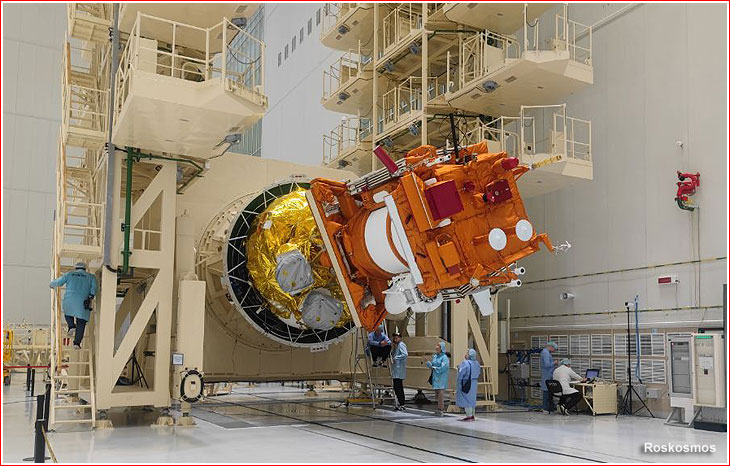
The payload section with the Fregat space tug, Meteor-M2-3 satellite and secondary payload is being prepared for encapsulation under its payload fairing.
Based on the procurement deadlines for the Soyuz-2-1b rocket assigned to carry the mission, the launch of the Meteor M2-3 was planned for before the end of 2020, but the project drifted several years behind schedule due to routine delays with the manufacturing.
The liftoff for the mission was first set for May 25, 2023, at 20:34 Moscow Time, but a reported technical problem with the spacecraft on March 6, 2023, forced it switch places in the launch manifest for the Vostochny spaceport with the Kondor-FKA No. 1 satellite, which was launched on May 27, 2023.
By the time the Meteor-M2-3 made it to Vostochny on May 6, 2023, its launch was postponed until June 27, 2023.
On June 8, 2023, Roskosmos reported that the 42 secondary payloads for the mission had arrived to Vostochny after being transported by an aircraft to Blagoveshensk.
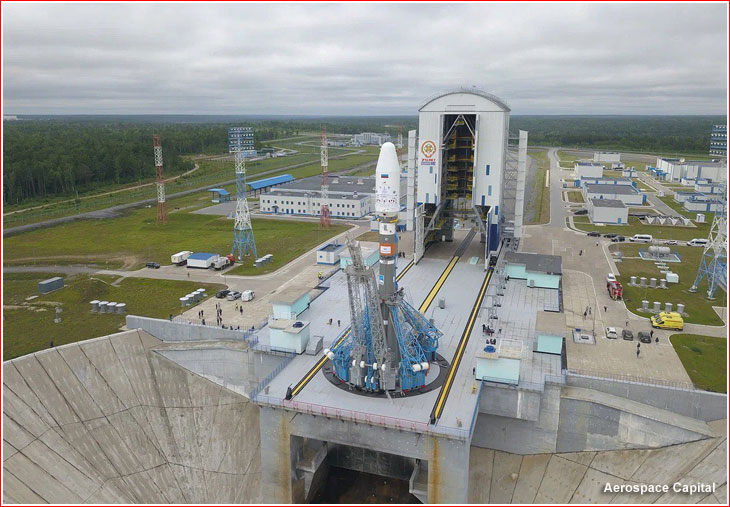
The final assembly of the Soyuz-2-1b launch vehicle for the mission was completed on June 23 and later in the day, the State Commission overseeing preparations for launch authorized the rollout of the rocket to the launch pad, which took place as planned on the morning of June 24, 2023.
How Meteor M2-3 was launched
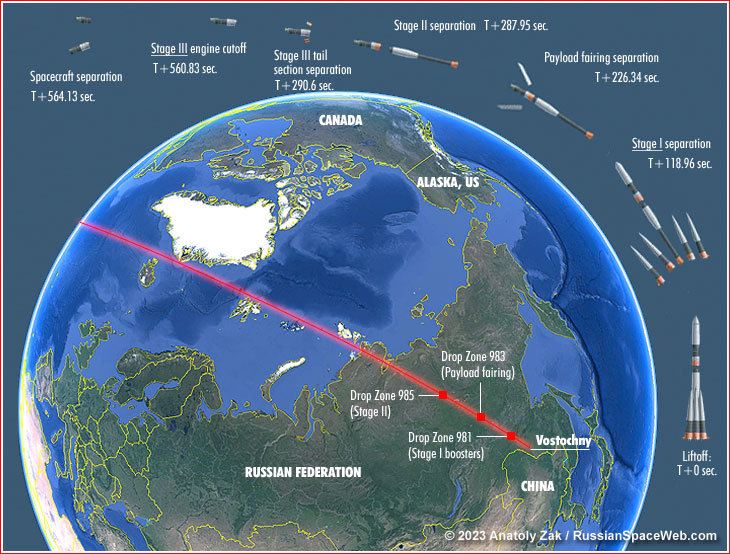
The Meteor-M No. 2-3 initial launch timeline:
| Milestone | Elapsed Time |
|---|---|
| Liftoff | 0 |
| Stage I separation | 118.96 seconds |
| Payload fairing separation | 226.34 seconds |
| Stage II separation | 287.95 seconds |
| Stage III aft section separation | 290.6 seconds |
| Stage III engine cutoff | 564.83 seconds |
| Stage III separation | 564.83 seconds |
A Soyuz-2-1b rocket with a Fregat upper stage carrying the Meteor M2-3 lifted off from the Soyuz launch complex in Vostochny on June 27, 2023, at 14:34:49.415 Moscow Time. The ascent profile of the mission was similar to three previous launches of Meteor satellites from the Far-Eastern launch site.
After a few seconds in a vertical ascent under the power of the four boosters of the first stage and the core booster of the second stage, the rocket headed northwest across eastern Russia, aligning its trajectory with a polar orbit inclined around 98.57 degrees toward the Equator and an azimuth of 344.13 degrees. The strap-on boosters of the first stage separated 1 minute 59 seconds after liftoff and aimed to crash at Drop Zone No. 981 in the Amurskaya Oblast (Amur Region) on the border between the Tynda and Zeya Districts.
The fairing protecting the payload then split in two halves and separated during the operation of the second stage at 3 minutes 46 seconds in flight. A a result, the payload fairing fragments were to fall at Drop Zone No. 983 in the Aldan District in the Sakha (Yakut) Republic.
Moments before the second stage completed its firing 4 minutes and 47 seconds into the flight, the RD-0124 engine of the third stage began to fire through the inter-stage lattice structure, which moments later separated along with the second stage 4 minutes and 48 seconds after liftoff.
Just 1.5 seconds later, the tail section on the third stage split into three segments. Both, the second-stage booster and the segments of the tail section fell at Drop Zone No. 985, in the Vilyusk District, located farther north in the Sakha Republic.
The third stage continued firing, inserting the Fregat upper stage and its passengers into an orbit with an apogee (highest point) of 196 kilometers and a perigee of just 12 kilometers or well in the dense atmosphere. As a result, after its engine cutoff and separation from Fregat, 9 minutes 24 seconds after liftoff, the third stage began a long free fall back to Earth over the Arctic and Northern Atlantic Oceans. Its trajectory was designed to bring the flaming debris of the booster crashing into the Atlantic Ocean.
Space tug flight profile
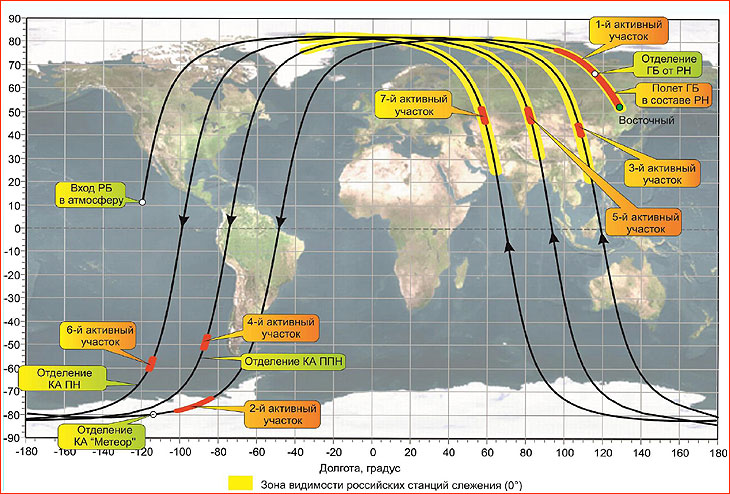
Following its split from the third stage, the Fregat was programmed to fire its engines over the Arctic Region 10 minutes 24 seconds after liftoff for around 1.5 minutes to ensure its insertion into a transfer orbit. The six-ton stack then expected to climb passively for around 46 minutes before Fregat had to fire for the second time near the apogee of its initial orbit, this time over the Antarctica, 57 minutes 53 seconds after liftoff. The maneuver, lasting less than a minute was designed to insert the vehicle into a nearly circular orbit around 830 kilometers above the Earth's surface. Around a minute later, or 59 minutes 52 seconds after liftoff and 15:34 Moscow Time (8:34 a.m. EDT), the Meteor M2-3 satellite was programmed to eject from Fregat's payload adapter, completing the main task of the mission. Because the initial engine firings were performed by the Fregat beyond the view of Russian ground stations, their successful completion would have to be confirmed during the subsequent passes of the vehicle over Russia.
After the successful release of its primary payload, the Fregat was to embark on a pre-programmed sequence to deliver its secondary payloads into their orbits, which would start with the third firing of the main engine to enter a transfer orbit 1 hour 39 minutes 15 seconds after liftoff. The separation orbit was to be formed with the fourth maneuver 2 hours 29 minutes 35 seconds after launch. The release of the secondary payloads was scheduled to begin 2 hours 33 minutes 20 seconds after liftoff, or at 17:10 Moscow Time (10:10 a.m. EDT) and was expected to be completed 3 hours 11 minutes 40 seconds after liftoff at 17:47 Moscow Time (10:47 a.m. EDT).
After the release of its final passenger, the Fregat was expected to conduct another pre-programmed maneuver to place itself on a suicide trajectory into the Earth's atmosphere and disintegrate over the Equatorial region in the eastern section of the Pacific Ocean.
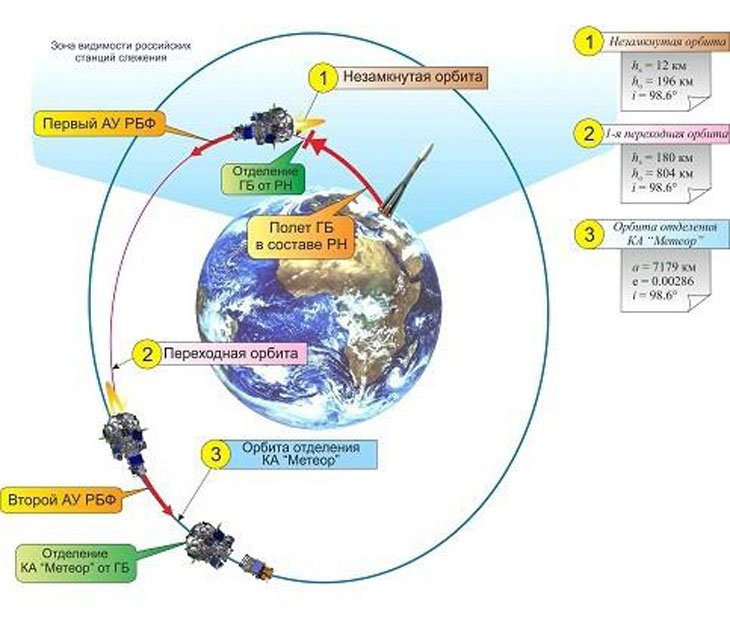
Following the launch, six months were officially allocated for in-orbit testing of the Meteor-M2-3 satellite.
The US Space Force published orbital parameters of the Meteor-M2-3 satellite several hours after the launch. According to this tracking data, the satellite was in the expected 809 by 816-kilometer orbit with an inclination 98.8 degrees toward the Equator. On June 28, 2023, Roskosmos published first photo from Meteor-M2-3.
StratoSat TK-1 releases six sub-satellites
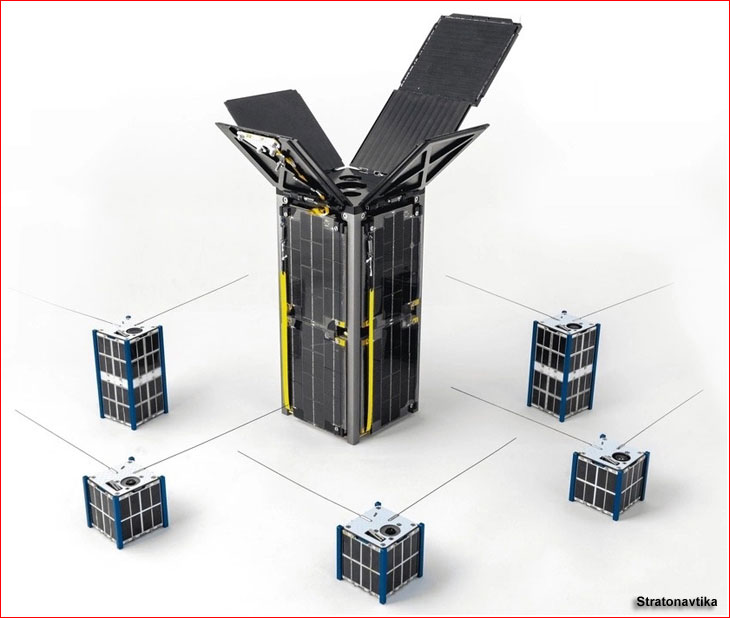
In the meantime, the Stratonavtika company said that six TinySat satellites had been released from the StratoSat TK-1 carrier satellite on July 11, 2023, at 09:40 Moscow Time. Four of the released satellites had a size of 5 by 5 by 5 centimeters and two others were 5 by 5 by 10 centimeters in size.
The company also promised a video of the separation process shot by a camera on one of the spacecraft, which was released shortly thereafter.
On March 15, 2024, Roskosmos announced that two Khors satellites had completed flight testing and began routine operations for the Russian meteorological agency Rosgidromet.
Next launch in the Meteor-M series: Meteor M2-4
Page author: Anatoly Zak; last update:March 15, 2024
Page editor: Alain Chabot; Last edit: June 26, 2023
All rights reserved
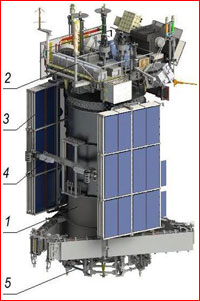
Meteor-M2-3 in folded position: 1- service module;
2 - payload module;
3/4 - solar panel;
5 - separation system (bottom ring remains on the upper stage after separation of the satellite. Credit: VNIIEM
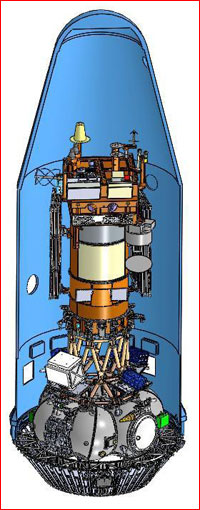
The payload section of the Meteor-M2-3 satellite. (Secondary payloads are shown notionally). Credit: Roskosmos
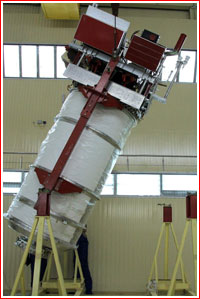
Meteor-M2-3 during assembly at VNIIEM.
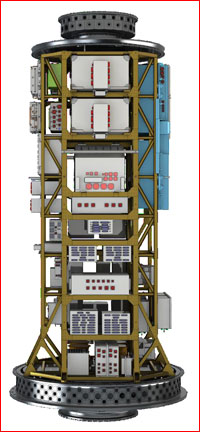
Instrument section of the Meteor-M2-3 satellite without its pressurized container.
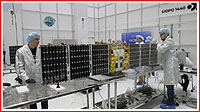
Pre-launch processing of the Rassvet-1 satellite. Credit: Buro 1440
CubeSat payloads are being integrated with their deployment container in preparation for the Meteor-M2-3 mission. Click to enlarge.
Click to enlarge. Credit: Buro 1440
The payload section with the Fregat space tug, Meteor-M2-3 satellite and secondary payloads is being prepared for encapsulation under its payload fairing. The folded antenna of the radar on the Meteor is visible on the foreground. Click to enlarge. Credit: Roskosmos
The upper composite of the Meteor-M2-3 mission, including the third stage of the Soyuz-2-1b launch vehicle and the payload fairing (encapsulating the Fregat space tug with the satellite) is being integrated with booster stages in the vehicle processing building of Vostochny Cosmodrome on June 23, 2023. Click to enlarge. Credit: Roskosmos
A Soyuz rocket with the Meteor-M2-3 satellite shortly after its rollout to the launch pad in Vostochny. Click to enlarge. Credit: Aerospace Capital
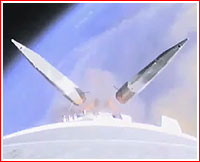
First stage booster separate from the Soyuz rocket with Meteor-M2-3 satellite as seen by an onboard camera. Credit: Roskosmos
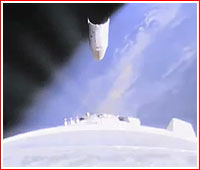
A payload fairing fragment separates from the Soyuz rocket with Meteor-M2-3 satellite as seen by an onboard camera. Credit: Roskosmos
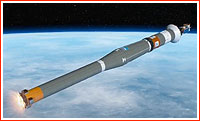
Artist rendering illustrating operation of the second stage during the launch of the Meteor M2 satellite. Credit: Roskosmos
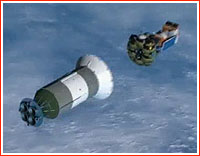
Artist rendering illustrating third stage separation during the launch of the Meteor M2 satellite. Credit: Roskosmos
Meteor M2-3 separates from the Fregat upper stage as seen by its onboard camera from the Obzor system. Click to enlarge. Credit: Roskosmos
The Saturn 6U Cubesat separates from the Fregat upper stage. Click to enlarge. Credit: Roskosmos
Yarilo No. 4 3U Cubesat separates from the Fregat upper stage. Click to enlarge. Credit: Roskosmos
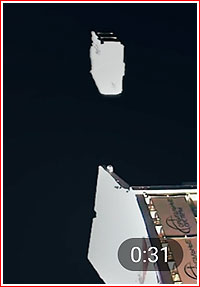
Avion 6U Cubesat separates from the Fregat upper stage. Credit: Roskosmos
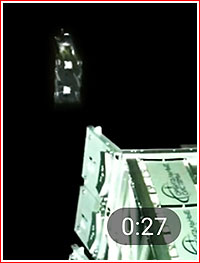
Khors No. 1 6U Cubesat separates from the Fregat upper stage. Credit: Roskosmos
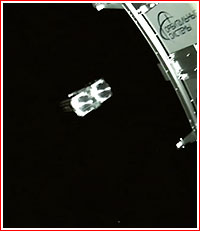
Impuls-1 6U Cubesat separates from the Fregat upper stage. Credit: Roskosmos
Onboard view from a Rassvet-1 satellite. (INSIDER CONTENT) Click to enlarge. Credit: Buro 1440
First photo from Meteor-M2-3 released by Roskosmos. Click to enlarge. Credit: Roskosmos
Release of sub-satellites from the Stratosat carrier. Click to enlarge. Credit: Roskosmos

)
)
)
)
)
)
)
)
)
)
)
)